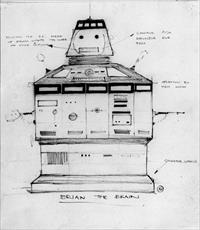Brian the Brain
Hijacked by a robot -a living machine with a brain, a human voice, and a terrifying secret. ITC summary
- Shooting script dated 5th May 1976. Revised 11 May. Filmed 18th May-2nd June
- In the script, the character name is "Brain" (not Brian). Brian is renamed
Marcel
in the French version of this episode. In the Italian version, he is "Cervello" (brain).
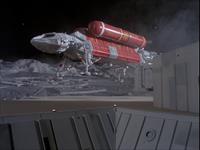
The Swift is a Ron Burton design, intended as the landing ship for Into Infinity. It was built by Martin Bower. The top tanks were added by the studio and contained freon gas for the engines.
Swift model feature
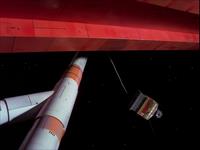
A large section of the Swift leg was built with a miniature Brian.
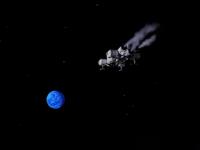
Planet D is represented by a blue monochrome version of a photograph of Earth. It was taken by Apollo 11 on 16th July 1969, about 10,000 nautical miles from Earth, and shows portions of North and Central America under swirling clouds. The picture is also used as Sunim in Matter Of Balance. Thanks to Marcus Lindroos.
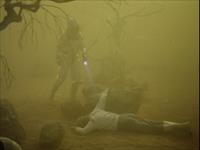
- "Our computer is assessing what we've learned from the past and transferring that data to the Main Computer memory banks." At first this sounds like a backup, but data should be transferred from the computer memory to backup storage, not into memory. Helena seems to be describing some sort of data analysis or data mining. It could also be describing machine learning, where the computer is trained on data to develop insights and algorithms (this is popularly known as artificial intelligence). The training model normally requires a large dataset, and the learning phase can be computationally intensive.
- Normal computer procedures involve taking back-ups (copies) of the data which can be restored if necessary. Like many PC users, the Alphans seem not have taken backups. While large companies and factories may have good backup policies, they can have complex networks of interdependent systems, which makes restoring one or more systems challenging. In the 2000s. hacking of company computers by criminals and nation states is common, both to steal information and to prevent the systems being used (denial of service).
- Brian may be inspired by Shakey The Robot, the first mobile robot to be able to reason about its own actions. The robot, looking like a box on wheels, had a TV camera and bump sensors. He was developed between 1966 and 1972 at the Stanford Research Institute in California.
- Ultra violet causes the lens of the eye to cloud (forming cataracts) and can cause skin cancers by damaging DNA. It is not painful as such, although ultra violet lamps (used for tanning) are too bright to look at directly. Why is it fitted in the Swift cabin? Did the Swift crew like to have tans?
- Planet D is "a small planet with no more gravity pull than we have". Planet D has similarities to Saturn's moon Titan, a little larger than the Moon, with a dense atmosphere of orange smog (made up of nitrogen and hydrocarbons). Most data about Titan comes from Voyager 1 (1980) and Cassini (2004). A small planet can retain a dense atmosphere if it is cold (-178 C on Titan). Despite the cold, the hydrocarbons could be rich in the building blocks of amino acids, which could produce life (if not on the scale of the petrified trees seen in the episode).
- A black dwarf is a term for two types of stellar object. In the 1960s it identified an object now known as a brown dwarf: an object of insufficient mass to ignite nuclear fusion (between 0.001 and 0.08 solar masses). The first was discovered in 1995 and now hundreds are known. The second type of black dwarf, and the common usage since the 1960s, is the final stage of a white dwarf, a dead star about the size of Earth weighing 1.4 solar masses. None should exist yet, as the universe is not old enough for white dwarfs to cool to this degree.
- NASA launched an unmanned spacecraft called the Swift in November 2004. From Earth orbit, the spacecraft telescopes observe gamma-ray bursts (GRB), allowing astronomers to map neutron stars and black holes.
1150 days after leaving Earth orbit (Wed 6 Nov 2002)
0 fatalities.
Alpha Technology:
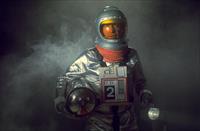
- In Dragon's Domain Cellini comments "There are ships here that could make the dream of interstellar travel a reality. We could be liberated from our solar system". However this episode shows a 1996 mission with a mothership and Swifts was launched beyond the solar system. Note while the Ultra Probe was a high profile public mission, no-one can even remember the Swift mission here. Also note the Swift uniforms are different to the standard moonbase uniforms worn by the Ultra Probe crew. Perhaps it was a different (more secretive) space organisation. Alternatively, it is possible the details of the mission were changed or invented by Brian, who had control of the Moonbase computer systems.
- Although they don't recognise the Swift, they do recognise the Superswift design in Bringers Of Wonder. Note that the design may have been heavily modified for the deep space mission.
- Brian says the Alpha computer doesn't talk. This contradicts many Year One episodes such as Breakaway, and Mark Of Archanon and All That Glisters where the Eagle computer talks.
- We see a silver version of the spacesuit (although the neck segment is orange). This is also seen in The Seance Spectre.
- The Alpha Log Recorder is seen (it's the trolley with yellow wheels).
- The nuclear detonator from Space Brain is seen in the passenger section of the Swift.
- Tony calls Weapons Section to target the Swift with "missiles". This is the only time missiles are mentioned- normally we see the "laser batteries".
Eagle 1 (Tony); 2 & 10 (investigation)
Mouse, Capt Michael
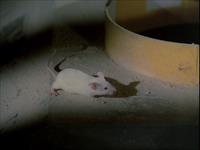
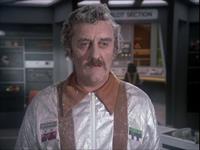
Planet D
Aliens:
None
Footage:
- The interior of the Swift does not match the exterior. The two rear airlocks, immediately behind the side doors, do not match the exterior, and the instrument-only pilot section does not have the viewports seen from the outside. From the outside, the side doors are on a lower level to the pilot section.
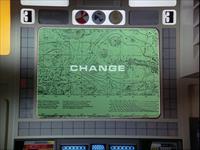
Tinted pages of an astronomy book are shown, including maps of the north pole of Mars. Most of the pages are from the New Concise Atlas Of The Universe by Patrick Moore (probably the 1974 edition). More. Thanks to Marcus Lindroos.
External Links
![]() Year 2 - Episode 9
Year 2 - Episode 9 ![]()





